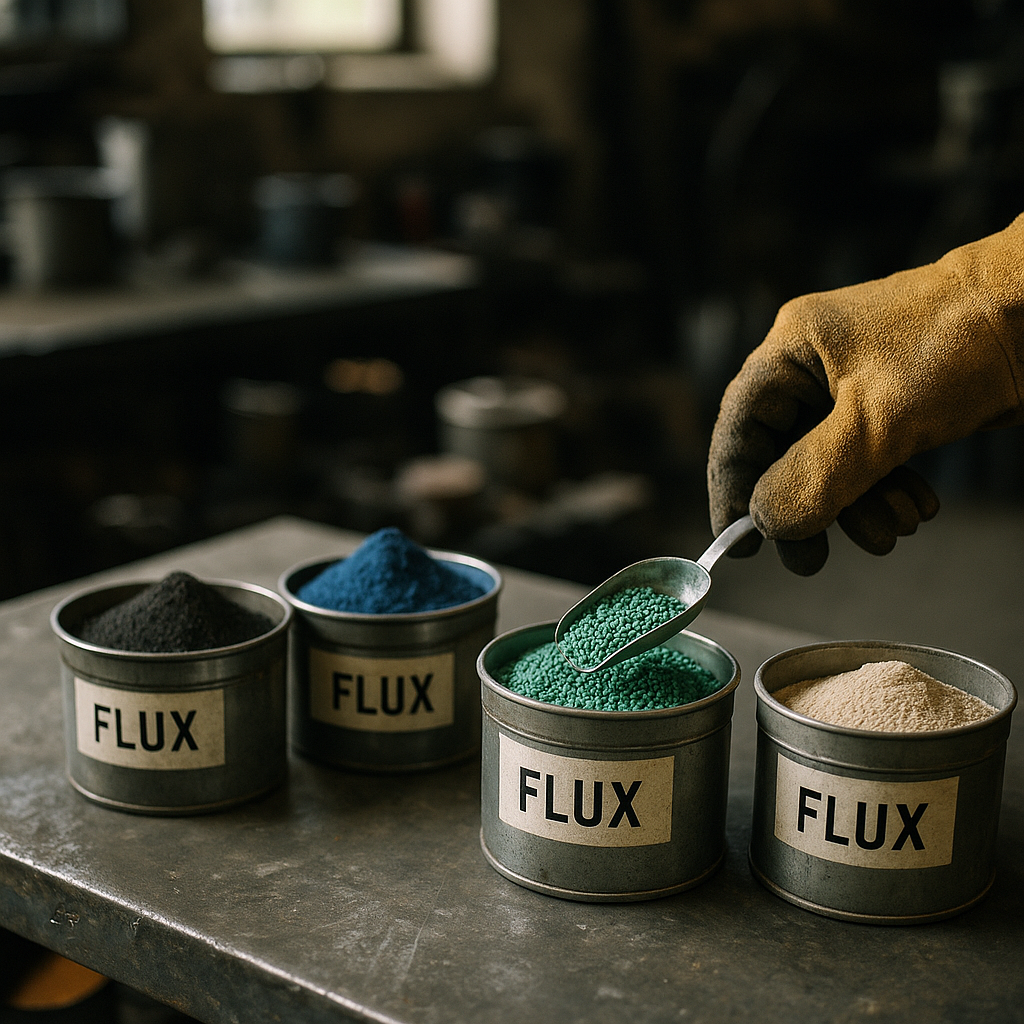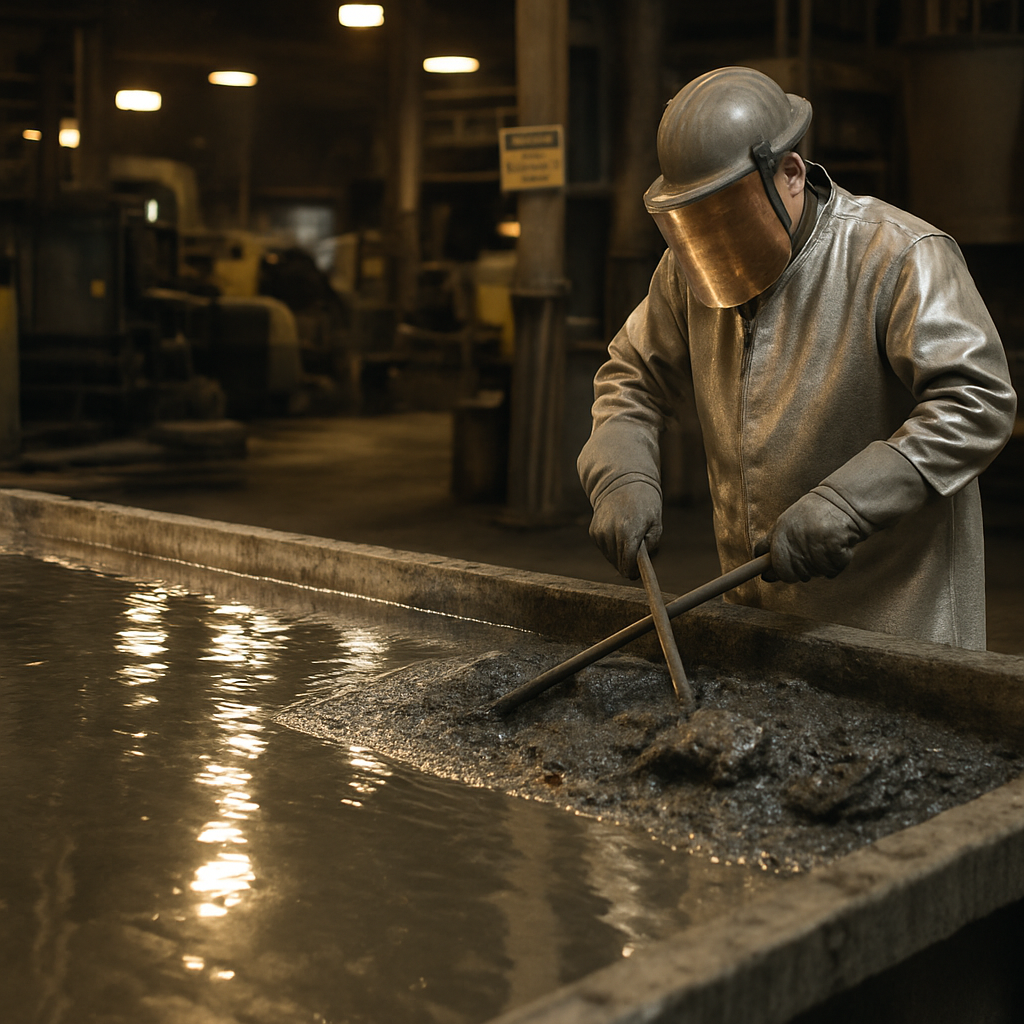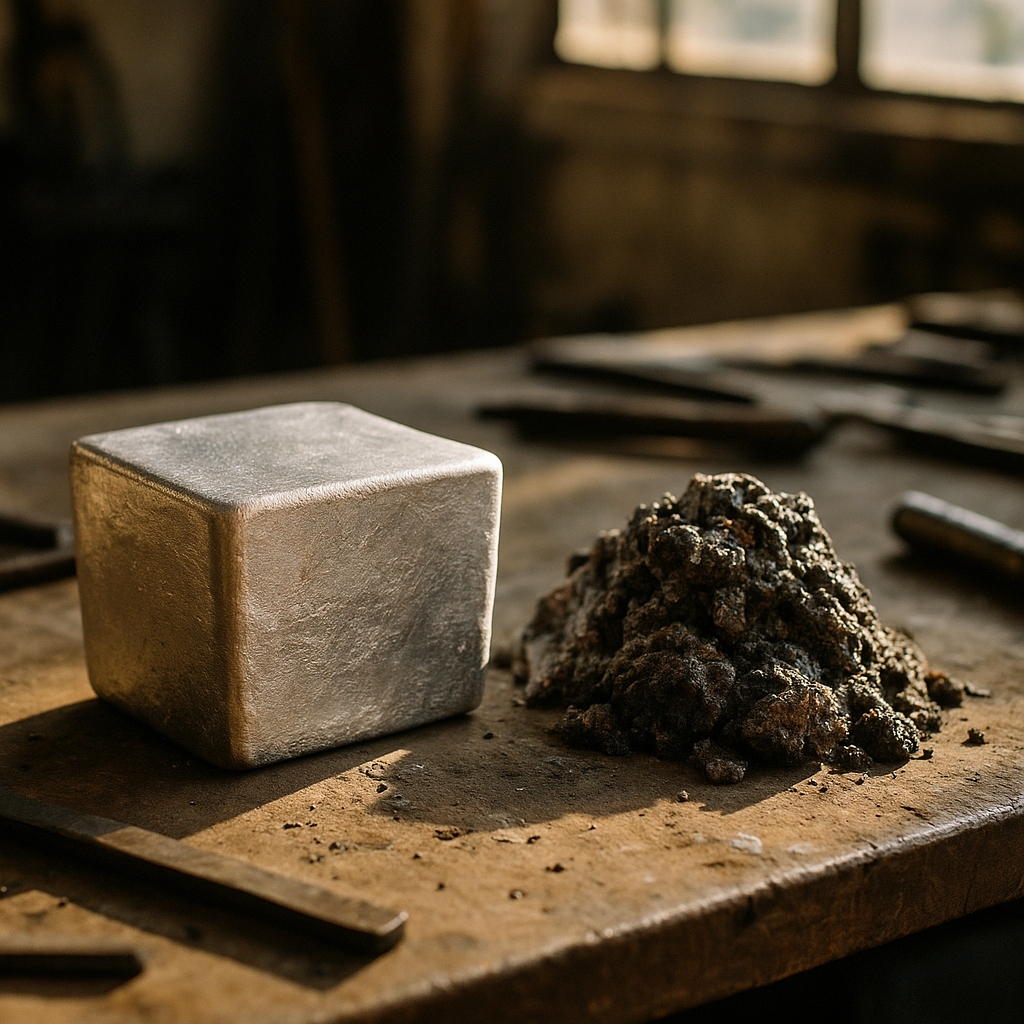5901 Botham Jean Blvd, Dallas, TX 75215
Fluxing Process in Metal Melting: How It Works, Types, & Benefits
October 23, 2025In metal recycling, the fluxing process is vital for transforming raw, impurity-laden metals into high-quality refined products. This process involves adding substances called fluxes to molten metal to remove impurities and enhance the final product’s quality. Flux acts like a cleaning agent for metals, effective at extreme temperatures where conventional methods fail.
During metal melting, fluxes perform key roles. They act as chemical reducing agents by breaking down oxides on the metal surface. Additionally, they serve as flowing agents to improve melt fluidity. Most importantly, they purify by capturing impurities and forming a separate layer called slag. This slag, being lighter than the molten metal, floats to the surface for easy removal, leaving behind purer metal.
The choice of flux depends on the metal being processed. For iron and steel production, limestone and dolomite are commonly used to form basic slags that remove silica and other acidic impurities. In aluminum processing, flux removes hydrogen gas and oxide inclusions. For precious metals like gold, borax-based fluxes help separate valuable metal from unwanted minerals. The science behind fluxing is a blend of chemistry and metallurgy, enabling efficient metal purification on an industrial scale.
What Are the Main Types of Fluxes Used in Metal Melting?

Fluxes play a crucial role in metal melting processes by removing impurities and oxides, improving metal flow, and enhancing the quality of the final product. Various types of fluxes are employed across different applications, each serving specific purposes in the metallurgical industry. Understanding these fluxes helps optimize recycling processes and ensures efficient resource utilization.
Basic and Acidic Fluxes
Metallurgical fluxes are typically categorized as either basic or acidic based on their chemical properties. Basic fluxes contain compounds that form bases when dissolved in water, while acidic fluxes form acids. This distinction determines how they interact with metal oxides and impurities during the melting process.
Limestone (calcium carbonate) and dolomite (calcium-magnesium carbonate) are common basic fluxes used extensively in iron and steel production. When heated, limestone decomposes to form calcium oxide, which reacts with acidic impurities like silica to form slag. This reaction is fundamental to the purification process in blast furnaces where iron is separated from ore impurities.
Silica (SiO₂) serves as a primary acidic flux in non-ferrous metal processing, particularly in copper smelting where it combines with iron oxides to form a fluid slag. The proper selection between basic and acidic fluxes depends on the specific metals being processed and the nature of impurities present.
Inorganic Fluxes for High-Temperature Applications
Inorganic fluxes are essential for high-temperature metallurgical processes. These fluxes contain mineral compounds that withstand extreme temperatures while facilitating chemical reactions that remove impurities.
Fluorite (calcium fluoride) is widely used in steelmaking to lower the melting point of slag and increase its fluidity. Typically added at a rate of 2-10 kg per ton of steel, fluorite helps improve the removal of sulfur and phosphorus impurities. Its effectiveness comes from its ability to break down the silicate networks in slag, making it more fluid at lower temperatures.
Borax (sodium tetraborate) functions as an excellent flux for brazing and welding applications. It forms a protective coating that prevents oxidation while dissolving metal oxides. In jewelry making and precious metal recycling, borax is invaluable for producing clean joints and facilitating the recovery of valuable materials.
Metal chlorides, particularly zinc chloride and ammonium chloride, are effective fluxes for soldering and metal joining applications. These compounds actively clean metal surfaces by dissolving oxides and providing a protective barrier against reoxidation during the soldering process.
Organic Fluxes for Lower Temperature Applications
Organic fluxes are primarily used in lower-temperature applications such as soldering electronics and plumbing. These fluxes contain organic compounds that are effective at removing oxides at temperatures below 450°C.
Rosin, derived from pine tree resin, represents one of the most widely used organic fluxes in electronics. It remains solid and non-corrosive at room temperature but becomes active when heated, gently removing oxides from copper and other metal surfaces. Rosin fluxes are often categorized by their activation levels:
- R (Rosin) – Pure rosin with no activators, mildest action
- RMA (Rosin Mildly Activated) – Contains mild activators, moderate cleaning action
- RA (Rosin Activated) – Contains stronger activators, more aggressive cleaning
Water-soluble organic fluxes contain compounds like glycols, organic acids, and surfactants. These fluxes provide excellent cleaning action and can be removed with water after soldering, making them valuable in applications where flux residue must be completely eliminated.
| Flux Type | Composition | Applications | Characteristics |
|---|---|---|---|
| Basic Flux | Limestone, Dolomite | Iron and Steel Production | Removes acidic impurities like silica |
| Acidic Flux | Silica (SiO₂) | Copper Smelting | Combines with iron oxides to form fluid slag |
| Inorganic Flux | Calcium Fluoride, Borax | Steelmaking, Brazing | Improves slag fluidity, provides protective coating |
| Organic Flux | Rosin, Glycols | Electronics, Plumbing | Effective at removing oxides at lower temperatures |
Specialized Fluxes for Challenging Metals
Some metals present unique challenges during melting and joining processes, requiring specialized flux formulations. Aluminum, for example, forms a tenacious oxide layer that conventional fluxes struggle to penetrate.
Aluminum fluxes typically contain fluoride compounds like cryolite (sodium hexafluoroaluminate) or potassium fluoroaluminate that can break down aluminum oxide. These specialized fluxes enable efficient recycling of aluminum, which requires only 5% of the energy needed to produce primary aluminum from bauxite ore.
Magnesium alloy fluxes must contain compounds that protect the highly reactive metal from oxidation and burning. These often include mixtures of chlorides and fluorides that form a protective barrier on the molten metal surface.
Stainless steel fluxes commonly contain a mixture of zinc chloride in hydrochloric acid, which effectively removes the chromium-rich oxide layer that makes stainless steel resistant to conventional fluxes. Proper handling and disposal of these more aggressive fluxes are essential to prevent environmental contamination.
Environmental Considerations in Flux Selection
As sustainability becomes increasingly important in manufacturing, the environmental impact of fluxes must be considered. Many traditional flux formulations contain compounds that can be harmful if released into the environment.
Modern flux development focuses on reducing or eliminating hazardous components while maintaining performance. Water-based and bio-derived fluxes represent significant advancements in this area, offering reduced volatile organic compound (VOC) emissions and improved worker safety.
Recycling facilities must carefully manage flux-containing slags and residues to prevent the release of potentially harmful compounds like fluorides and heavy metals. Many metallurgical slags can be repurposed for applications such as road construction, cement manufacturing, and agricultural soil amendments, turning waste products into valuable resources.
The selection of appropriate fluxes not only improves metallurgical processes but also affects the recyclability of the final products. Using compatible and environmentally responsible flux systems helps ensure that metals can be efficiently recovered at the end of their useful life, supporting circular economy principles.
How Does the Fluxing Process Work in Metal Melting?
The fluxing process is essential for purifying metals by removing impurities and oxides from molten metal. When metals are heated to their melting point, they quickly react with oxygen in the air, forming oxide layers that can degrade the final product’s quality. Fluxes address this problem through various chemical reactions.
Operators add flux materials directly to the molten metal bath during metal melting. Since fluxes are less dense than metal, they float to the surface, where most impurities accumulate. Here, the flux performs several vital functions.
First, the flux dissolves existing oxide layers on the metal surface. These oxides, such as aluminum oxide (Al₂O₃) or iron oxide, are chemically broken down by the active compounds in the flux. For example, halide compounds in many fluxes can disrupt the crystalline structure of metal oxides.
Next, the flux absorbs and captures impurities throughout the metal bath. As these impurities and dissolved oxides combine with the flux, they form slag—a separate layer floating on top of the purified molten metal. The slag layer contains all the unwanted elements removed from the metal.
The flux also creates a protective barrier on the metal surface, preventing further oxidation during heating. This barrier function is crucial during longer melting operations where exposure to air would typically cause significant oxidation and metal loss.
Once the fluxing process is complete, the slag layer is physically separated from the purified metal, usually by skimming the surface with specialized tools. The result is cleaner metal with fewer inclusions and improved properties.
The effectiveness of the fluxing process depends on several factors. The temperature must be high enough for the flux to remain liquid and chemically active. The flux must be well mixed with the molten metal to ensure complete contact with impurities. The flux composition must be suitable for the specific metal being processed, as different metals require different flux formulations.
In industrial applications, flux can be introduced through various methods. Basic methods involve manually sprinkling flux powder over the metal surface. More advanced techniques use injection systems, where flux is blown into the metal bath using inert gases like argon or nitrogen, ensuring deeper penetration and more thorough purification.
In aluminum processing, flux injection is particularly effective. The flux particles are carried by gas bubbles throughout the molten bath, capturing hydrogen gas and oxide particles as they rise to the surface. This not only removes impurities but also helps prevent porosity in the final cast product.
| Function of Flux | Resulting Layer | Description |
|---|---|---|
| Breaks down oxides | Oxide Layer | Dissolves existing oxide layers on the metal surface |
| Captures impurities | Slag | Contains unwanted elements, floats on top of pure metal |
| Prevents further oxidation | Protective Barrier | Guards against oxidation during heating |
What Are the Benefits and Challenges of Using Fluxes in Metal Melting?

In metal recycling operations, fluxes play a critical role in improving metal quality and process efficiency. These specialized chemical compounds perform essential functions during metal melting that directly impact the quality of recovered materials and the sustainability of the recycling process. Understanding their advantages and limitations helps recycling facilities optimize metal recovery operations.
Benefits of Using Fluxes in Metal Melting
Fluxes offer significant advantages that make them essential to efficient metal recovery and processing:
- Impurity Removal and Oxidation Prevention: Fluxes effectively trap and remove oxides, hydrogen, and other impurities from molten metal. They create a protective barrier that prevents atmospheric oxygen from interacting with the metal bath, significantly reducing oxidation. This protection is particularly important for reactive metals like aluminum, which quickly forms aluminum oxide (Al2O3) when exposed to oxygen.
- Improved Metal Recovery: When properly applied, quality drossing fluxes can reduce the metallic content in dross by over 50%. This translates to substantial material recovery that would otherwise be lost in the recycling process, improving both economic outcomes and resource efficiency.
- Enhanced Flow Characteristics: Fluxes can increase the wetness of liquid metal, allowing it to flow more evenly over surfaces. This property is valuable in processes where metal must form consistent, high-quality surfaces.
- Lower Energy Consumption: By preventing oxide formation and improving heat transfer within the molten bath, fluxes can contribute to lower melting temperatures and reduced energy usage. This creates both economic and environmental benefits for recycling operations.
- Worker Safety Improvements: Properly applied fluxes, particularly in submerged arc processes, can reduce harmful emissions, sparks, and splatter during metal processing. This creates safer working conditions by minimizing exposure to fumes and reducing fire hazards.
Challenges and Limitations of Flux Usage
Despite their benefits, fluxes present challenges that must be carefully managed:
- Potential for Introducing New Impurities: Incorrect flux formulations can introduce unwanted elements into the metal. This is particularly problematic when working with high-purity alloys where even minor contamination can affect material properties.
- Corrosion Risks: Some flux compositions, particularly those containing fluorides, chlorides, and other halides, can cause corrosion in equipment and refractory linings. Over time, this corrosion can lead to costly repairs and maintenance.
- Hazardous Fume Generation: Many fluxes produce fumes during the melting process that can be harmful if inhaled. Proper ventilation and personal protective equipment are essential when working with these materials to protect worker health.
- Risk of Excessive Thermite Reactions: Improper flux application can lead to excessive thermite reactions, which can consume valuable aluminum and generate intense heat. These reactions not only waste recoverable metal but can also create safety hazards for workers.
- Environmental Considerations: Spent flux and dross require proper disposal or further processing as they may contain environmentally harmful compounds. Sustainable recycling operations must account for these byproducts in their waste management strategies.
Critical Factors for Effective Flux Selection and Application
The success of flux usage in metal melting depends on several key factors:
First, proper flux selection is essential. Different metal types and alloys require specific flux formulations. For example, aluminum recycling typically uses flux containing potassium chloride (KCl) and sodium chloride (NaCl) as base compounds, with various additives depending on the specific application. When working with aluminum that contains magnesium, flux composition must be adjusted to address the formation of magnesium aluminate (spinel) that can cause black speck inclusions.
Second, application technique significantly impacts effectiveness. Flux must be applied in the correct quantity and with proper mixing to achieve optimal results. Too little flux fails to provide adequate protection, while excessive flux can lead to metal loss through thermite reactions. Developing and documenting standardized procedures for each furnace type and metal composition ensures consistent results.
Third, timing of application matters. Wall cleaning fluxes, for instance, should be applied before scheduled cleanings when refractory surfaces are red hot for maximum effectiveness. Regular maintenance schedules that incorporate appropriate flux treatments prevent excessive buildup that can reduce furnace efficiency and lifespan.
| Flux Type | Application | Advantages | Challenges |
|---|---|---|---|
| Basic Fluxes | Iron and Steel Production | Removes silica and acidic impurities | Proper selection based on metal impurities is necessary |
| Acidic Fluxes | Non-ferrous Metal Processing | Easily combines with iron oxides to form slag | Must be tailored to specific metal requirements |
| Inorganic Fluxes | High-Temperature Metallurgical Processes | Withstands extreme temperatures, facilitates chemical reactions | Can cause corrosion in equipment and refractories |
| Organic Fluxes | Soldering Electronics and Plumbing | Effective at lower temperatures, non-corrosive when not heated | Cleaning of residues required to prevent issues |
Understanding these benefits, challenges, and critical factors enables recycling operations to maximize the value of recovered metals while maintaining safe and environmentally responsible practices. Proper flux selection and application represent one of the most cost-effective ways to improve both the quality and quantity of recycled metals while reducing energy consumption and operational costs.
Conclusion: The Crucial Role of Fluxing in Metal Melting

The fluxing process is a crucial component in metal melting operations. Acting as a chemical reducing agent, fluxes effectively dissolve and remove oxide layers that naturally form on metal surfaces. This essential function not only prevents further oxidation but also enhances the flow of molten metals during smelting and joining processes.
In various industries, from electronics manufacturing to large-scale metallurgical operations, fluxes are key to producing high-quality metal. They enable more efficient melting by lowering operating temperatures, reducing energy consumption, and significantly improving the purity of final metal products by separating impurities into easily removable slag. Without proper fluxing, metals would contain defects, impurities, and compromised structural properties.
As metallurgy advances, optimizing fluxing processes remains vital for meeting stringent quality standards while minimizing environmental impact. For professional guidance on recycling metal byproducts from fluxing operations, contact Okon Recycling at 214-717-4083.
